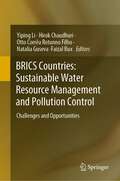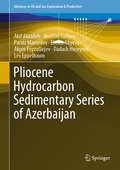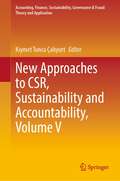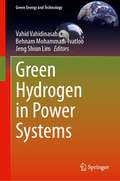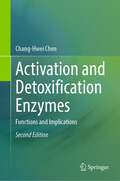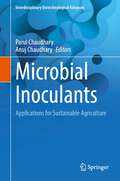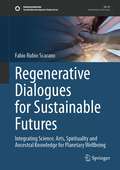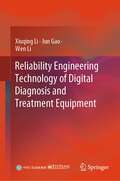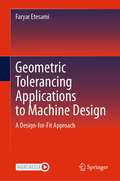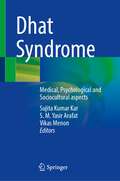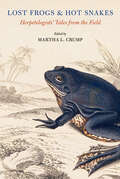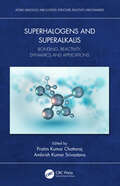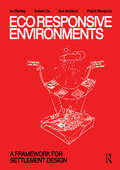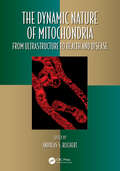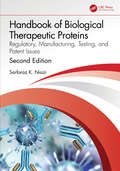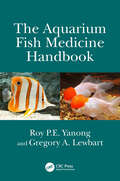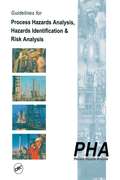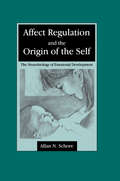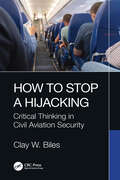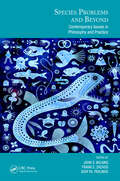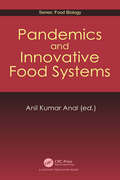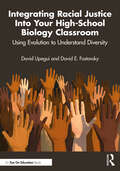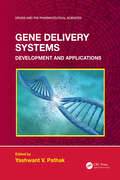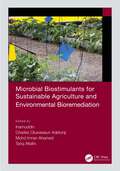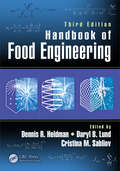- Table View
- List View
BRICS Countries: Challenges and Opportunities
by Yiping Li Hirok Chaudhuri Otto Corrêa Rotunno Filho Natalia Guseva Faizal BuxThis book provides a detailed study and assessment of water resources management andpollution control in different BRICS countries. The regions involved areBrazil, Russia, India, China and South Africa. This book gives importantinsight into how future sustainability depends on the development of effectivewater governance mechanisms at the level of countries. According to theregional characteristics from different aspects it cuts into the waterenvironment problems and studies in different ways, which is multifaceted andtargeted. Using case studies that include environmentally integrated basinexperiments (eibex) of Brazil, groundwater overflow zone of India, semi-aridriver basin of South Africa and so on, this volume provides criticalinformation for researchers and policymakers.
Pliocene Hydrocarbon Sedimentary Series of Azerbaijan (Advances in Oil and Gas Exploration & Production)
by Akif Alizadeh Ibrahim Guliyev Parviz Mamedov Elmira Aliyeva Akper Feyzullayev Dadash Huseynov Lev EppelbaumThis book demonstrates different stages of hydrocarbon deposit localization in a tectonically complex region—the South Caspian Mega-Basin (SCMB). Each of the stages: tectonics, sedimentation, lithology, structural analysis, and geophysical method application is described in detail and accompanied by numerous color (major) and black-white (minor) illustrations. The main benefit of this book is that the Azerbaijan hydrocarbon province has been investigated for more than 150 years, resulting in a very comprehensive archive of geological information. This book is intended not only for students of various degrees, but also for professional geologists studying principles of hydrocarbon accumulations under difficult geological environments.
New Approaches to CSR, Sustainability and Accountability, Volume V (Accounting, Finance, Sustainability, Governance & Fraud: Theory and Application)
by Kıymet Tunca ÇalıyurtThis book continues the discussion from the first four volumes on the challenges that organizations face in order to implement sustainability, ethics, and effective corporate governance, all of which are important elements of “standing out” from other companies. Examining the background of the New European Consensus on development with the new guiding motto ‘Our World, Our Dignity, Our Future,’ the authors explore how this new legislation on sustainability issues around the world is forcing companies to deal directly with sustainability issues. The 2030 Agenda for Sustainable Development (2030 Agenda), adopted by the United Nations in September 2015, is the international community’s response to global challenges and trends in connection with sustainable development. With the Sustainable Development Goals (SDGs) at its core, the 2030 Agenda is a transformative political framework designed to eradicate poverty and achieve sustainable development globally. It balances the economic, social, and environmental dimensions of sustainable development, including the key issues of governance and peaceful and inclusive societies, and recognizes the essential interlinkages between its goals and targets, i.e., that they must be implemented as a whole and not selectively. The respective chapters in this volume raise a number of questions regarding corporate social responsibility, ethics, and corporate governance in the face of new technology and new approaches to climate change and sustainability reporting.
Green Hydrogen in Power Systems (Green Energy and Technology)
by Vahid Vahidinasab Behnam Mohammadi-Ivatloo Jeng Shiun LimGreen Hydrogen in Power Systems examines state-of-the-art applications and the latest developments in technology, protocols, implementation, and application of green hydrogen in power and energy systems. The first book to comprehensively analyze the opportunities and challenges in this field, it brings together global experts from different disciplines to provide a comprehensive study of the role of green hydrogen in power systems of the future and its important role in energy evolution and decarbonization efforts around the world. The book is a multidisciplinary reference for researchers and industry stakeholders who have focused on the field of hydrogen integration into the power and energy systems, as well as researchers and developers from different branches of engineering, energy, computer sciences, data, economic, and operation research fields.
Activation and Detoxification Enzymes: Functions and Implications
by Chang-Hwei ChenThis book discusses the many advances in the understanding of the functions and implications of activation and detoxification enzymes. This organized, concise overview will meet the needs of those who are initially exposed to this important subject, particularly for students and researchers in the areas of biomedical sciences, biochemistry, nutrition, pharmacology, and chemistry. The book will also be valuable to advanced researchers. The book discusses subjects associated with foreign-compound-metabolizing enzymes with emphasis on biochemical aspects, including lipophilic foreign compounds, activation and detoxification enzymes, metabolic enzyme catalytic properties, reactive metabolic intermediates, biomedical and biochemical effects, genetic polymorphisms, enzyme inducibility, enzyme modulation for health benefits, dietary-related enzyme modulators, and structural characteristics of enzyme inducers. This new edition is updated throughout andfeatures completely new chapters on Oxidative and Electrophilic Stresses, Metabolite- Mediated Disease Conditions, and Defense Mechanism: Nrf2-ARE Pathway.
Microbial Inoculants: Applications for Sustainable Agriculture (Interdisciplinary Biotechnological Advances)
by Parul Chaudhary Anuj ChaudharyThis book discusses the role of microbes in agriculture for plant attributes, soil fertility, and bio-remediation, which aid in sustainable agriculture. Nowadays, due to increase in human population, it is essential to increase food productivity in the near future, but exhaustive non-sustainable agricultural practices such as the usage of agrochemicals threaten food security, the economy, and the environment globally. Soil deterioration is the most serious environmental threat to food production, resulting in poverty and hunger in developing countries. As a result, the global community has faced challenges regarding the development of ecologically sound, efficient, and long-term alternative options to meet rising food requirements. Therefore, to contribute to food security, the advancement of sustainable and innovative modern agriculture aimed at addressing environmental, economic, and social challenges connected with present intense non-sustainable agriculture practices is required. As a result, beneficial microbial inoculants will be widely used in the development of new strategies to increase sustainable food production. Bioinoculant application helps to provide nutrients that directly support soil health and sustainable food production. Hence, this book offers the role of microbial inoculants for better agronomical performance for sustainable advancement in agriculture and also pays attention to soil health improvement for extensive period benefits. The book will be highly recommended for agriculture microbiologists, agronomists, plant pathologists, and related areas.
Regenerative Dialogues for Sustainable Futures: Integrating Science, Arts, Spirituality and Ancestral Knowledge for Planetary Wellbeing (Sustainable Development Goals Series)
by Fabio ScaranoThis book is about sustainability in its broadest sense. It argues that the ongoing science-policy dialogue on sustainable development (as framed by the United Nations’ Sustainable Development Goals) is insufficient to drive the planet to desired sustainable futures. This conversation, followed by transformative action, must be inclusive of other forms of interpretation of reality (arts, spirituality, and ancestral knowledge) and non-modern cosmovisions. This is more a book about dialogues than about the common dualism problem/solution, and such dialogues are approached as an essential trigger of regeneration. The book takes the reader from a historical perspective of the human-nature relationship through to a discussion on sustainable futures as utopias. The optimism conveyed by the book is justified by a plethora of global examples of such regenerative dialogues.
Reliability Engineering Technology of Digital Diagnosis and Treatment Equipment
by Xiuqing Li Jun Gao Wen LiThis book focuses on the reliability engineering of medical devices, especially digital diagnosis and treatment equipment in China. It details the professional technologies and application methods of reliability design analysis, fault model analysis and reliability test of digital diagnosis and treatment equipment, to meet the needs of project undertakers of digital diagnosis and treatment equipment. From the three aspects: safety analysis and EMC design protection, material selection and control, and software engineering and quality, this book provides professional and technical ideas and methods of reliability for the quality problems prone to occur in the field of medical devices, as well as method guidance for readers. Meanwhile, it runs through the whole process of design, engineering, testing, production and management of all digital diagnosis and treatment equipment research and development enterprises and even product R & D enterprises in the field of medicaldevices. It is used as reading materials for personnel of testing institutions and evaluation institutions in medical devices.
Geometric Tolerancing Standard to Machine Design: A Design-for-Fit Approach
by Faryar EtesamiThis book is for students enrolled in undergraduate mechanical engineering, or similar, programs. The material presented is based on nearly thirty years of class-tested lecture notes for courses on the applications of geometric tolerancing for designers. The book’s emphasis is on fit requirements for machine components, as fit assurance makes up the majority of challenging applications in tolerancing. For design engineers, knowing how to apply geometric tolerances has been a challenge even for engineers who have practiced geometric tolerancing for a long time. The syntax and meaning of geometric tolerancing statements can be learned easily and quickly, but knowing how to use them correctly is much more difficult. In the Design-for-Fit approach, the presentation starts with the geometric requirements for various kinds of fit and then presents the geometric tolerance statements necessary to achieve those fits.
Dhat Syndrome: Medical, Psychological and Sociocultural aspects
by Sujita Kumar Kar S. M. Yasir Arafat Vikas MenonDhat Syndrome is known as a culture-bound syndrome in South Asia. People with Dhat Syndrome often present with anxiety and distress related to semen loss. Multiple somatic and sexual symptoms often accompany this. The symptoms of Dhat Syndrome closely resemble other neurotic and stress-related disorders. Myths related to sexuality are often the core phenomenon in dhat syndrome, which is responsible for the generation of psychopathology—addressing the myth's preliminary results in resolving psychopathology. However, many patients require pharmacological and psychological management. Due to strong cultural beliefs and associated myths, patients with Dhat Syndrome often reach out to traditional healers before getting the proper psychiatric consultation, further consolidating their myths and poor attitude toward treatment. However, Dhat Syndrome resembles a male entity; a similar entity is reported in females, where females attribute their non-pathological vaginal discharge to psychological distress. The pattern of symptoms has a significant resemblance with Dhat Syndrome in males. There is no standard book that exclusively discusses various aspects of Dhat Syndrome. This book examines the evolution of Dhat Syndrome to the current understanding of the disease and its management. Hence, this book will be unique and helpful for this disorder.
Lost Frogs and Hot Snakes: Herpetologists' Tales from the Field
by Martha L. CrumpLost Frogs and Hot Snakes reveals the thrills and travails that herpetologists experience when working with amphibians and reptiles in the wild. With essays from fifty field biologists, this volume, edited by Martha L. Crump, presents a multifaceted yet intimate look at life in pursuit of knowledge about the natural world. From the beaches of Peru to the mountains of China, the stories in this collection place readers in the boots of field biologists as they watch, count, experiment, and survey. Some recall mishaps and misadventures—contending with leeches, dangling off a precipice while in a truck. Others tell of once-in-a-lifetime encounters—discovering a new frog species, spotting a rare snake. Together, these stories offer an understanding of what field biology is, what field biologists do, and how they go about doing it. Written with candor, warmth, and a dash of humor, the stories in Lost Frogs and Hot Snakes will encourage readers to appreciate the value of engaging with nature and of the amphibians and reptiles so critical to the vitality of our planet.
Superhalogens and Superalkalis: Bonding, Reactivity, Dynamics and Applications (Atoms, Molecules, and Clusters)
by Pratim Kumar Chattaraj Ambrish Kumar SrivastavaSuperhalogens and Superalkalis is a comprehensive volume designed as the go-to resource on the exciting and evolving topics of these special classes of atomic clusters and the acid salt that results from their interactions. The book details how these substances possess not only unusual structures but also unique properties which can be exploited for various applications. Superhalogens’ strong oxidizing capacity, resulting from their high-electron affinity, leads to their applications in the design of superacids, organic superconductors, and ionic liquids. The low ionization energy of superalkalis enables them to act as strong reducing agents, making them useful in the design of superbases and alkalides. Illustrated throughout, this timely book provides an overview of the research and development on these and other aspects of superhalogen and superalkalis. Key features: Offers a basic introduction of superatoms that is accessible for readers to understand. Includes extensive study questions after each chapter. Provides a systematic presentation of the existing literature on this increasingly trending topic. Presents the latest developments in the field, offering readers state-of-art knowledge. This book is a key reference guide for graduate students, postdocs, upper-level undergraduate students, academic professionals, and researchers who are interested in this fascinating topic.
EcoResponsive Environments: A Framework for Settlement Design
by Ian Bentley Soham De Sue McGlynn Prachi RampuriaEcoResponsive Environments integrates our current knowledge of designing for human needs, with a deeper understanding of natural systems. The book offers both a call to action and a comprehensive yet pragmatic framework for practising the art and science of settlement design, called EcoResponsive Design.Bridging the gap between theory and generic policy on the one hand, and design for specific places and sites on the other, the book is aimed not only at the professionals involved in planning, designing and developing these places, but also the wider range of communities interested in creating better spaces for our everyday lives.EcoResponsive Design encompasses all scales, ranging from the overall form of settlements and the landscapes in which they sit, to buildings and the detailed design of public spaces. Drawing from projects, places and best practices in many different countries and contexts across the world, it demonstrates how positive changes at the local scale can be achieved for every single site, large or small. The book urges a shift in focus from individual specialisms to collaborative actions, enabling development stakeholders to negotiate a balance between short-term financial viability and longer-term environmental and social values.
The Dynamic Nature of Mitochondria: from Ultrastructure to Health and Disease (Oxidative Stress and Disease)
by Andreas S. ReichertMitochondrial research has exploded over the last ~150 years. This book gives an amazing view on a conceptual change in our understanding of mitochondrial biology. It becomes clear that mitochondria are extremely dynamic in nature, controlling life at multiple levels. Mitochondria rule energy conversion, adapt cells well to changing stress and nutrient conditions, and regulate many cellular processes including immunity. The dynamic nature of mitochondria occurs at an intramitochondrial level but also includes its ability to interact with other organelles and to modulate multiple signalling pathways. It is thus not surprising that alterations or inabilities to ensure this dynamic behaviour is linked to ageing and human diseases.The following sections give an updated view on mitochondria: Mitochondrial ultrastructure: molecular mechanisms shaping the inner membrane Mitochondrial cristae and lipid dynamics: from super-resolution microscopy to lipid-OXPHOS interplay Mitochondrial control of cellular homeostasis: from redox signalling to interorganellar contact sites Mitochondria in health and disease: from mtDNA release to Complex I assembly Advanced methods in mitochondrial biology and metabolism research Integrative view on mitochondrial research and outlook The field of mitochondrial research has always been full of surprises and has helped science to advance tremendously. It developed hand in hand with landmark developments in technology, such as super-resolution microscopy (nanoscopy), and is currently influencing an increasing number of scientific disciplines. There is still much ‘new’ to find out about this ‘old’ organelle and I think that you can find interesting and also unexpected aspects of mitochondrial biology in this book. I hope the book will enhance your scientific curiosity and inspire your own research.
Handbook of Biological Therapeutic Proteins: Regulatory, Manufacturing, Testing, and Patent Issues
by Sarfaraz NiaziSince 1972, which marks the invention of recombinant engineering, more than 500 therapeutic proteins have been approved for clinical use. Today, biological drugs constitute almost 70% of all new drugs and have a biological origin. The first edition of this book dealt with biosimilars, and this edition (i.e., the second edition) focuses on new drugs, yet limits to therapeutic proteins. Newer technologies for drug development represent the updated topics in the book and include repur-posing, AI- driven identification of newer designs, novel expression systems, manufacturing using these systems, rapidly changing regulatory pathways, and legal hurdles. This edition discusses how to identify, develop, manufacture, and take multibillion dollar products to market within the shortest possible time. Features: Complete and thorough coverage of the regulatory and technological challenges of developing generic therapeutic proteins Comprehensive, discovery to market, newer technologies, regulatory planning and IP hurdles are included that are not found elsewhere Expanded volume that must be in the hands of every company interested in biological drugs, including the mRNA-based biopharmaceutical companies fast appearing on the market Discusses how to identify, develop, manufacture, and take multibillion dollar products to market in the shortest possible time Renowned author and entrepreneur in the field of drug discovery and production
The Aquarium Fish Medicine Handbook
by Roy P.E. Yanong Gregory A. LewbartPracticing veterinarians, veterinary technicians, professional aquarists, fish researchers, and tropical fish hobbyists will find this thorough yet concise handbook a complete how-to guide for keeping fish under human care healthy and thriving. Whether you're new to fish medicine and husbandry or an expert in the field, there is valuable information within these pages for you. The book is arranged in a logical order so that readers can quickly and efficiently find the information they seek. The book is filled with valuable and applicable information on dozens of topics including how to manage aquatic life support systems for fish, history taking, natural history, anatomy, physiology, diagnostic techniques, anesthesia, analgesia, and surgery. Virtually all of the most important ornamental fish pathogens, including viruses, bacteria, fungi, and parasites, are described and richly illustrated. There are also sections on fish welfare and conservation.While there are many books on the market that explore the topics of ornamental fish health and care, none provide the amount of helpful information and resources in such a small, affordable package.
Guidelines for Process Hazards Analysis (PHA, HAZOP), Hazards Identification, and Risk Analysis
by Nigel HyattThis unique manual is a comprehensive, easy-to-read overview of hazards analysis as it applies to the process and allied industries. The book begins by building a background in the technical definition of risk, past industrial incidents and their impacts, ensuing legislation, and the language and terms of the risk field. It addresses the different types of structured analytical techniques for conducting Process Hazards Analyses (PHA), provides a "What If" checklist, and shows how to organize and set up PHA sessions. Other topics include layout and siting considerations, Failure Modes and Effect Analysis (FMEA), human factors, loss of containment, and PHA team leadership issues.
Affect Regulation and the Origin of the Self: The Neurobiology of Emotional Development
by Allan N. SchoreDuring the past decade a diverse group of disciplines have simultaneously intensified their attention upon the scientific study of emotion. This proliferation of research on affective phenomena has been paralleled by an acceleration of investigations of early human structural and functional development. Developmental neuroscience is now delving into the ontogeny of brain systems that evolve to support the psychobiological underpinnings of socioemotional functioning. Studies of the infant brain demonstrate that its maturation is influenced by the environment and is experience-dependent. Developmental psychological research emphasizes that the infant's expanding socioaffective functions are critically influenced by the affect-transacting experiences it has with the primary caregiver. Concurrent developmental psychoanalytic research suggests that the mother's affect regulatory functions permanently shape the emerging self's capacity for self-organization. Studies of incipient relational processes and their effects on developing structure are thus an excellent paradigm for the deeper apprehension of the organization and dynamics of affective phenomena. This book brings together and presents the latest findings of socioemotional studies emerging from the developmental branches of various disciplines. It supplies psychological researchers and clinicians with relevant, up-to-date developmental neurobiological findings and insights, and exposes neuroscientists to recent developmental psychological and psychoanalytic studies of infants. The methodology of this theoretical research involves the integration of information that is being generated by the different fields that are studying the problem of socioaffective development--neurobiology, behavioral neurology, behavioral biology, sociobiology, social psychology, developmental psychology, developmental psychoanalysis, and infant psychiatry. A special emphasis is placed upon the application and incorporation of current developmental data from neurochemistry, neuroanatomy, neuropsychology, and neuroendocrinology into the main body of developmental theory. More than just a review of several literatures, the studies cited in this work are used as a multidisciplinary source pool of experimental data, theoretical concepts, and clinical observations that form the base and scaffolding of an overarching heuristic model of socioemotional development that is grounded in contemporary neuroscience. This psychoneurobiological model is then used to generate a number of heuristic hypotheses regarding the proximal causes of a wide array of affect-related phenomena--from the motive force that drives human attachment to the proximal causes of psychiatric disturbances and psychosomatic disorders, and indeed to the origin of the self.
How to Stop a Hijacking: Critical Thinking in Civil Aviation Security
by Clay W. BilesHijackings and bombings have plagued civil aviation since 1930 and air rage incidents are on the rise. While there is aircraft and inflight training available for air marshals, other first responders receive minimal training on inflight security awareness and protocols. There are no other resources currently available to flight crews or armed first responders that specifically address inflight security and how to address threats of disturbances on airplanes.How to Stop a Hijacking provides readers with fundamental principles on how to think more critically about onboard security threats. The aircraft cabin poses unique environment and security challenges, and first responders can apply security awareness and critical thinking skills to establish a safer environment in the cabin and airport for everyone onboard. The lessons in this book are driven with the central objective of teaching the reader how to counter inflight aggression and maintain tactical control of the cabin. Written by a former federal air marshal instructor, this book looks at the recent rash of air rage incidents and violence on airplanes, in addition to the real and ever-present threat of hijack or potential explosive device.How to Stop a Hijacking is a practical guide that offers methodological and tactically proven strategies for stopping violent acts onboard an aircraft inflight.
Species Problems and Beyond: Contemporary Issues in Philosophy and Practice (Species and Systematics)
by John S. Wilkins, Frank E. Zachos, and Igor Ya. PavlinovSpecies Problems and Beyond offers a collection of up-to-date essays discussing from an interdisciplinary perspective the many ramifications of the ‘Species Problem.’ The authors represent experts in the philosophy of biology, in species-level evolutionary investigations, and in biodiversity studies and conservation. Some of the topics addressed concern the context sensitivity of the term ‘species’; species as individuals, processes, natural kinds, or as ‘operative concepts’; species delimitation in the age of Big (genomic) Data; and taxonomic inflation and its consequences for conservation strategies. The carefully edited volume will be an invaluable resource for philosophers of biology and evolutionary biologists alike. – Olivier Rieppel, Rowe Family Curator of Evolutionary Biology, Negaunee Integrative Research Center, Field Museum, USASpecies, or ‘the Species Problem’, is a topic in science, in the philosophy of science, and in general philosophy. In fact, it encompasses many aspects of the same problem, and these are dealt with in this volume. Species are often thought of as fundamental units of biological matter to be used in ecology, conservation, classification, and biodiversity. The chapters in this book present opposing views on the current philosophical and conceptual issues of the Species Problem in biology.Divided into four sections, Concepts and Theories, Practice and Methods, Ranks and Trees and Names, and Metaphysics and Epistemologies, the book is authored by biologists, philosophers, and historians, many leaders in their fields. Topics include ontology of species, definitions of both species category and units, species rank, speciation issues, nomenclature, ecology, and species conservation.Species Problems and Beyond aims to clarify the contemporary issues of the Species Problem. It is ideal for use in upper-level seminars and courses in Evolutionary Biology, Philosophy of Science, Philosophy of Biology, Systematics and Taxonomy, and Phylogenetics/Cladistics, and for any scholar in these fields.
Pandemics and Innovative Food Systems (Food Biology Series)
by Anil Kumar AnalThe debate on health, nutrition and food security could not have arisen at a more opportune time. The recent pandemic has given rise to increased food and nutrition insecurity for individuals, families, and communities. The crisis threatened the food security and nutrition of millions of people, many of whom were already suffering. We face possible disruptions to the functioning of food systems, with severe consequences for health and nutrition. Pandemics create a greater burden for poorer countries and countries since they are already pressure of inadequate food supplies. With concerted action, we can not only avoid some of the worst impacts but do so in a way that supports a transition to more sustainable food systems that are in better balance with nature and that support healthy diets – and thus better health prospects for all. This book aims to highlight the impact of pandemics in food systems and nutrition security. It draws on the experience from the past and present pandemics to better prepare the world for future crises.
Integrating Racial Justice Into Your High-School Biology Classroom: Using Evolution to Understand Diversity
by David Upegui David E. FastovskyIn this guide, educators and authors David Upegui and David E. Fastovsky offer a pedagogical prescription for how you can integrate the study of racial justice with evolutionary biology in your existing high-school biology curriculum.Designed as a practical manual for teaching, the chapters focus on teaching concepts of equity through evolutionary biology modules, a cornerstone for building students’ scientific understanding of biotic diversity. The book provides pedagogical components alongside historical and scientific components, with contextual chapters that give teachers the background knowledge to understand the historical relationship between science and racism for topics such as natural selection, social justice, and American slavery and colonization. Ready-to-use lesson plans are situated in a historical and theoretical context of science as it relates to racial oppression, and demonstrate how rigorous science education can lead to your students’ liberation and personal empowerment despite the historically problematic history of some applications of science. These lesson plans and classroom exercises are presented in a way that introduces the timely extra dimension of anti-racism into the existing biology curricula without significantly increasing teaching loads. The contextual material provided allows the lessons to be implemented across a variety of classrooms regardless of initial familiarity with DEI.Ideal for secondary biology teachers and their students, particularly in grades 10-12, this book synthesizes timely ideas for high-school educators, harnessing the power of rigorous science to combat marginalization. Lessons and activities have been classroom-tested and are aligned with three different standards: Next Generation Science Standards (NGSS); College board (AP Biology); Vision and Change; and use the 5E format.
Gene Delivery Systems: Development and Applications (ISSN)
by Yashwant V. PathakThis unique volume in our Drugs and Pharmaceutical Sciences series covers the development of gene therapy today, the technology involved, clinical applications of siRNA, non-viral vector-based mRNA delivery using nanotechnology, and RNA based vaccines for treating the infectious diseases. It also presents the current application of the CRISPR/Cas9 gene-editing technique which has revolutionized genome editing and which was awarded the 2020 Nobel Prize in Chemistry. Several new drug delivery systems are explored for the applications of gene therapy. These are found to be useful in treating chronic illnesses, including cancer and infectious diseases. Key Features: Overview of the development of gene therapy Provides the most up to date information on the development of gene therapy, from the technology involved to gene correction and genome editing Presents CRISPR gene therapy recent trends and applications Discusses siRNA, mRNA, and DNA plasmids
Microbial Biostimulants for Sustainable Agriculture and Environmental Bioremediation
by InamuddinToday, the agriculture industry is confronted with simultaneous issues of how to fully embrace mass production of safer food in terms of both quality and quantity. Most industries are concerned with avoiding significant levels of soil pollution and environmental threats as a result of the excessive and harmful use of synthetic products on crops. Therefore, there is a need to adopt sustainable technological innovations that can ensure the sustainability of agricultural production systems.Microbial Biostimulants for Sustainable Agriculture and Environmental Bioremediation discusses the benefits, challenges, and practical applications of eco-friendly biotechnological techniques using biostimulants derived from beneficial microorganisms. The chapters cover the use of these organisms to increase crop production, enhance soil fertility and maintain soil health, create crop and plant tolerance to different abiotic stressors, release required nutrients to the soil, increase resistance to plant pathogens/pests, improve nutrient use efficiency of crops, and rejuvenate polluted environments.FEATURES Explores the physiological, morpho-anatomical, and biochemical molecular plant rejoinders involved in stimulating crop productivity Provides information on the physiological, cellular, and molecular modes of action underlying microbial biostimulant interfaces Summarizes methods and approaches for executing microbial stimulant technology Outlines numerous environmental management and remediation strategies This book is an ideal resource for researchers, engineers, and academics working in soil science, crop science, water remediation, microbiology, and biotechnology.
Handbook of Food Engineering
by Edited by Dennis R. Heldman Daryl B. Lund Cristina M. SabliovAs the complexity of the food supply system increases, the focus on processes used to convert raw food materials and ingredients into consumer food products becomes more important. The Handbook of Food Engineering, Third Edition, continues to provide students and food engineering professionals with the latest information needed to improve the efficiency of the food supply system.As with the previous editions, this book contains the latest information on the thermophysical properties of foods and kinetic constants needed to estimate changes in key components of foods during manufacturing and distribution. Illustrations are used to demonstrate the applications of the information to process design. Researchers should be able to use the information to pursue new directions in process development and design, and to identify future directions for research on the physical properties of foods and kinetics of changes in the food throughout the supply system.Features Covers basic concepts of transport and storage of liquids and solids, heating and cooling of foods, and food ingredients New chapter covers nanoscale science in food systems Includes chapters on mass transfer in foods and membrane processes for liquid concentration and other applications Discusses specific unit operations on freezing, concentration, dehydration, thermal processing, and extrusion The first four chapters of the Third Edition focus primarily on the properties of foods and food ingredients with a new chapter on nanoscale applications in foods. Each of the eleven chapters that follow has a focus on one of the more traditional unit operations used throughout the food supply system. Major revisions and/or updates have been incorporated into chapters on heating and cooling processes, membrane processes, extrusion processes, and cleaning operations.
